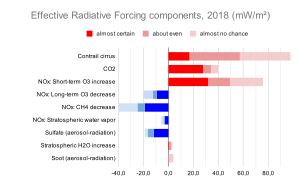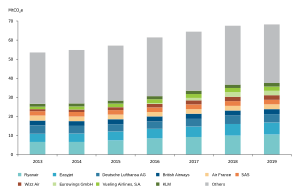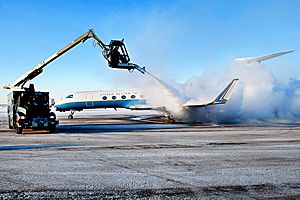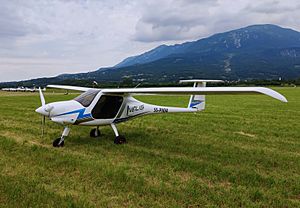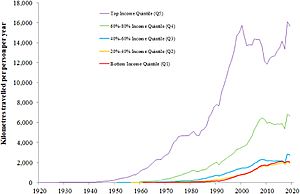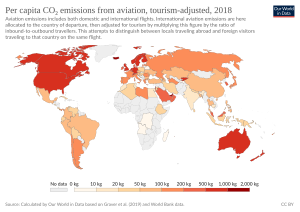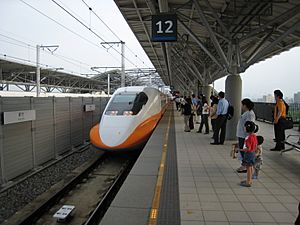Environmental effects of aviation facts for kids
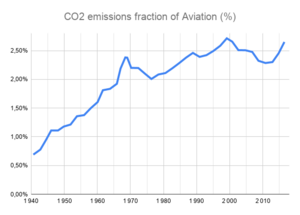
Airplanes use fossil fuels, and when their aircraft engines burn these fuels, they release gases, noise, and tiny particles into the air. This causes worries about how aviation affects our planet and the air quality in local areas.
Large passenger planes, called jet airliners, add to climate change. They release carbon dioxide (CO2), which is a well-known greenhouse gas. They also release other things like nitrogen oxides, contrails (the white lines you see in the sky), and small particles. Scientists are still learning exactly how much these other things affect the climate.
In 2018, flights around the world created 2.4% of all CO2 emissions.
Planes have become much better at using fuel. Between 1967 and 2007, they became 70% more fuel-efficient. This means they use less fuel to travel the same distance. In 2018, the amount of CO2 released per passenger per kilometer was 47% less than in 1990.
Even though planes are more fuel-efficient, the total amount of pollution has gone up. This is because more and more people are flying. By 2020, aviation emissions were 70% higher than in 2005, and they could go up by 300% by 2050!
Noise from planes can make it hard to sleep, affect how children learn in school, and might even increase the risk of heart problems.
Airports can also cause water pollution. They handle a lot of jet fuel and chemicals used for deicing planes in winter. If these spill and aren't cleaned up properly, they can pollute nearby rivers and lakes.
Flying also releases ozone and tiny particles called ultrafine particles, which can be bad for our health. Smaller planes, often used for general aviation, burn a type of fuel called Avgas, which releases toxic lead into the air.
There are ways to make flying more environmentally friendly. Planes can be designed to use less fuel, and air traffic control can find better flight routes to reduce pollution. Using special fuels made from plants, or schemes like emissions trading and carbon offsetting, can help lower CO2 emissions. People can also choose to fly less, especially for short trips, or use trains instead. New types of planes like hybrid electric aircraft, electric aircraft, or hydrogen-powered aircraft could also help.
Since 2021, major aviation groups like the IATA and the ICAO have set goals to have zero net carbon emissions by 2050.
Climate Change and Airplanes
How Airplanes Affect Climate
Airplanes release gases like carbon dioxide (CO2), water vapor, nitrogen oxides, and carbon monoxide. They also release tiny particles like soot. These mix with the air and affect our climate.
Jet airliners, especially when they fly high up in the atmosphere (a layer called the tropopause), contribute to climate change in four main ways:
- Carbon dioxide (CO2)
- This is the biggest and most understood way planes affect climate change. The CO2 released by planes has the same effect on the climate no matter how high they fly. Even things like airport vehicles, cars used by passengers, and building airports add to the total greenhouse gases from the aviation industry.
- Nitrogen oxides (NOx)
- When planes release NOx high in the sky, it helps create ozone (O3). This ozone acts like a greenhouse gas and warms the planet. However, NOx also helps reduce another greenhouse gas called methane, which has a cooling effect. Overall, the warming from ozone is usually stronger.
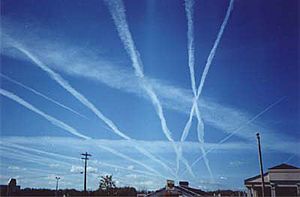
- Contrails and cirrus clouds
- When planes burn fuel, they produce water vapor. High up in the cold, humid air, this water vapor can turn into visible white lines called condensation trails, or contrails. These contrails can trap heat and warm the Earth, though less than CO2. Sometimes, contrails can even grow into larger, thin clouds called cirrus clouds, which also have a warming effect. Scientists are still studying exactly how much contrails and cirrus clouds contribute to global warming.
- Particulates
- Planes also release tiny particles, like sulfate and soot. Sulfate particles can actually have a slight cooling effect by reflecting sunlight, while soot particles absorb heat and cause warming. These particles can also affect how clouds form and behave. Soot particles are especially important because they can help contrails form. Reducing the amount of certain chemicals in jet fuel can help lower soot production.
Scientists have estimated that the overall warming effect from aviation, including these other factors, is greater than just the effect of CO2 alone. For example, in 2018, the total warming effect from aviation was about 3.5% of all human-caused warming.
How Much Air Travel Happens
In 2018, airlines carried 4.3 billion passengers on 37.8 million flights. This means each flight carried about 114 passengers on average. People traveled a total of 8.26 trillion kilometers by air.
Air travel has been growing steadily, almost doubling every 15 years. Even with occasional setbacks, it grows by about 4.3% each year. This growth is expected to continue.
Even though planes are much more fuel-efficient now (using half the fuel per flight compared to 1990), the total amount of pollution has gone up because so many more people are flying. Between 1960 and 2018, the total distance flown by passengers increased by more than 75 times!
In 2015, aviation was responsible for 2.5% of global CO2 emissions. By 2018, this was 2.4% of all CO2 emissions, totaling 918 million tonnes.
Between 1990 and 2006, greenhouse gas emissions from planes in the European Union went up by 87%.
About 60% of aviation emissions come from international flights. These flights are not covered by big climate agreements like the Kyoto Protocol or the Paris Agreement. However, the International Civil Aviation Organization (ICAO) has set a goal to cap airline carbon emissions at 2020 levels. This means airlines can buy carbon credits from other industries to make up for their emissions.
How Efficient Are Planes?
Fuel is a huge cost for airlines, so they have a strong reason to use less of it. This also helps the environment.
Jet airliners became 70% more fuel-efficient between 1967 and 2007. This improvement comes from better engines (40%) and better aircraft design (30%). The biggest improvements happened earlier in the jet age, from 1960 to 1980.
By 2018, the CO2 emissions per unit of cargo or passenger transport were more than cut in half compared to 1990.
In 2018, passenger flights released 747 million tonnes of CO2 for 8.5 trillion passenger kilometers. This works out to about 88 grams of CO2 per passenger per kilometer. To give you an idea, a long-haul flight might release 102 grams of CO2 per passenger per kilometer.
The ICAO aims for a 2% improvement in fuel efficiency each year until 2050. The IATA wants to cut net CO2 emissions in half by 2050 compared to 2005 levels.
What the Future Holds
Even with new technologies that make planes more efficient, aviation CO2 emissions continue to grow because more people are flying.
Some experts believe that if air travel keeps growing as predicted, aviation emissions alone could use up a huge part of the world's carbon budget, making it very hard to keep global warming below 2°C.
In 2013, scientists predicted that increasing CO2 levels would lead to a big increase in turbulence during transatlantic flights by the middle of this century.
The International Energy Agency thinks that aviation's share of global CO2 emissions could grow from 2.5% in 2019 to 3.5% by 2030.
By 2020, global international aviation emissions were about 70% higher than in 2005. The ICAO predicts they could grow by over 300% by 2050 if nothing more is done.
However, by 2050, the negative effects of aviation on climate could be reduced. This would happen through better fuel efficiency, lower NO
x emissions from advanced aircraft, improved flight procedures, and using renewable alternative fuels.
Noise Pollution
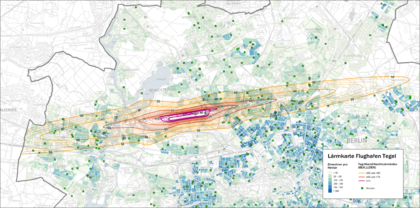
Noise from planes can disturb sleep, make it harder for children to do well in school, and might increase heart problems for people living near airports. To reduce sleep problems, some airports ban or limit flights at night.
Newer plane engines are designed to be quieter. For example, engines with a higher bypass ratio make less noise. Some engine parts also have special shapes, like serrated edges, to reduce noise.
Pilots can also use a "Continuous Descent Approach" (CDA) when landing. This means the plane descends steadily with less engine power, which makes less noise on the ground. CDA can reduce noise by about 1 to 5 decibels per flight.
Water Pollution
Airports can cause a lot of water pollution because they use and handle large amounts of jet fuel, lubricants, and other chemicals. If these chemicals spill, they can be stopped or cleaned up using special equipment like vacuum trucks and absorbent materials.
In cold weather, airports use deicing fluids to remove ice from planes and runways. Most of these fluids fall to the ground and can be carried by surface runoff into nearby streams, rivers, or coastal waters. These deicing fluids often contain chemicals like ethylene glycol or propylene glycol.
When these chemicals break down in water, they use up a lot of dissolved oxygen. Fish and other aquatic animals need enough dissolved oxygen to survive. Low oxygen levels can harm or even kill aquatic life, changing the types of animals that live in the water.
Some deicing fluids can also be harmful to humans and animals. Scientists are working to find safer, non-toxic alternatives.
Air Pollution
Aviation is a major source of ozone from human activities. Ozone can be bad for our lungs and is estimated to cause about 6,800 early deaths each year.
Airplane engines also release very tiny particles called ultrafine particles (UFPs) in and around airports. These particles are also released by ground support equipment.
In the United States, many smaller, private planes use a fuel called Avgas, which contains lead. Between 1970 and 2007, these planes released about 34,000 tons of lead into the air. The Federal Aviation Administration (FAA) warns that breathing or swallowing lead can harm the nervous system, blood, and immune system. For babies and young children, lead exposure can lead to learning and behavior problems, and even lower IQ.
Reducing Environmental Impact
We can reduce the environmental impact of aviation in several ways: flying less, finding better flight paths, limiting emissions, restricting short flights, increasing taxes on flying, and reducing financial help for the aviation industry. New technologies, like electric planes and biofuels, can also help.
In 2016, the International Civil Aviation Organization (ICAO) set goals to improve airplane fuel efficiency by 2% each year and to keep carbon emissions from 2020 onwards at the same level as 2010.
To reach these goals, they identified several actions:
- Using more fuel-efficient aircraft technology.
- Developing and using sustainable aviation fuels (SAFs).
- Improving air traffic management (ATM).
- Using market-based solutions like emission trading and carbon offsetting.
In 2021, Europe's aviation industry announced a plan called Destination 2050 to reach zero CO2 emissions by 2050. They plan to do this through:
- Better aircraft technology (37% reduction).
- Sustainable aviation fuels (34% reduction).
- Economic measures (8% reduction).
- Better air traffic control and operations (6% reduction).
In October 2021, the IATA promised to achieve net-zero carbon emissions by 2050. The ICAO agreed to this goal in 2022.
Making aviation carbon-free by 2050 will require steady improvements in efficiency, new engines for short flights, more sustainable aviation fuel production, and removing CO2 from the air to balance other warming effects.
Sustainable aviation fuels (SAFs) are currently more expensive than regular jet fuel. However, as technologies for making green hydrogen and capturing carbon from the air improve, synthetic fuels could become more affordable. Government policies like tax credits for cleaner fuels could also help.
A 2023 study by the Royal Society suggested that to reach net-zero emissions, fossil aviation fuel needs to be replaced with a low or zero-carbon energy source. Battery technology isn't likely to be powerful enough for large planes.
Biofuels can be used quickly with few changes to planes, but there might not be enough of them. Producing enough green hydrogen for planes would be expensive and require big changes to planes and airports. Synthetic fuels also need green hydrogen and large-scale carbon capture.
Technology Improvements
Electric Aircraft
Electric aircraft don't produce any emissions when they fly, and the electricity can come from renewable energy. However, Lithium-ion batteries are much heavier for the amount of energy they store compared to jet fuel. This means electric power isn't practical for long-distance flights right now.
Experts believe that large, long-haul planes probably won't be electric before 2070. But smaller planes can be electrified sooner. As of May 2020, the largest electric plane was a modified Cessna 208B Caravan.
Some predictions suggest that electric or hybrid planes could be used for short flights (like London to Paris) by the early 2030s. By 2050, these planes could make up 70% of the fleet, greatly reducing CO2 emissions. However, there are challenges like the limited supply of batteries and the fact that batteries can be fragile and catch fire.
Hydrogen-Powered Aircraft
In 2020, Airbus showed off ideas for planes powered by liquid hydrogen. They hope to have zero-emission airliners by 2035. Hydrogen could be a key fuel for industries that are hard to electrify, like aviation.
A 2020 study found that hydrogen could power short-range planes (under 2,000 km) by 2035, reducing their climate impact by 70-80%. Medium and long-range planes could also use hydrogen turbines, reducing their climate impact by 40-60%. However, a lot of research and new airport infrastructure would be needed.
Sustainable Aviation Fuels (SAF)
Sustainable aviation fuels (SAFs) are fuels made from things like used cooking oil, agricultural waste, or even algae. They can reduce greenhouse gas emissions by a lot compared to traditional jet fuel. SAFs can be used in existing planes without major changes. However, producing enough SAFs for all flights is a big challenge.
Electrofuels (e-fuels)
Electrofuels, or e-fuels, are made using electricity, water, and captured CO2. They are a type of synthetic fuel. While they are currently very expensive to produce, their cost could drop significantly by 2050. E-fuels could be a good option for aviation, especially when direct electrification isn't possible.
Reducing Air Travel
Reducing how much people fly is another way to lower aviation's environmental impact.
Studies show that only about 3% of the world's population flies regularly. In fact, about 1% of the world's population is responsible for half of all commercial aviation's CO2 emissions, while nearly 90% of people don't fly in a given year.
Measures to Reduce Flights
- Short-haul flight ban: Some countries are considering banning short flights where a train journey could be a good alternative. This encourages people to choose more environmentally friendly travel options.
- Flight shame: In Sweden, a movement called "flygskam" (flight shame) has encouraged people to fly less. This has led to more people choosing trains over planes for their travels.
- Personal allowances: One idea is to give everyone a "carbon allowance" for their emissions, which would reduce over time. People could trade these allowances. Another idea is to put a limit on how many flights each person can take.
Economic Measures
Emissions Trading
The ICAO supports emissions trading to reduce aviation CO2 emissions. This means that airlines are given a limit on their emissions. If they emit less, they can sell their extra "carbon credits" to other companies that emit more. This gives airlines a reason to become more efficient. The European Union has included aviation in its Emissions Trading Scheme since 2012.
Taxation and Subsidies
Financial measures can make flying less attractive and encourage people to use other ways of travel. They also motivate airlines to be more fuel-efficient.
- Air passenger taxes: These are paid by passengers, sometimes varying by distance.
- Departure taxes: Paid by passengers leaving a country.
- Jet fuel taxes: Paid by airlines for the fuel they use. In the United States, jet fuel is taxed, but in the European Union, it's not.
Cutting financial help (subsidies) for flying and instead supporting sustainable travel options can also influence people's choices. Many people in Europe support a carbon tax on flights.
Because there are low or no taxes on aviation fuel, air travel often has a cost advantage over other ways of traveling.
Carbon Offsetting
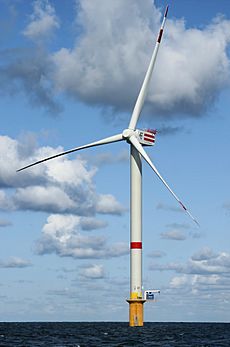
A carbon offset is a way to make up for aviation emissions. It means investing in projects that either save carbon from being released or absorb carbon from the air. For example, planting trees helps absorb carbon.
However, some people question how effective carbon offsets are. For instance, a study found that many rainforest offset credits might not actually lead to real carbon reductions.
What Consumers Can Do
Some airlines offer passengers the option to buy carbon offsets for their flights. This money is then invested in green technology like renewable energy or research into future technologies. Many major airlines offer this option. You can also buy offsets directly from organizations that certify them.
What Airlines Are Doing
Some airlines have committed to being "carbon-neutral." This means they balance their carbon emissions by investing in projects that reduce or remove an equal amount of carbon from the atmosphere.
For example, in 2019, Air France announced it would offset CO2 emissions for all its domestic flights. EasyJet also decided to offset carbon emissions for all its flights, becoming the first major airline to claim carbon neutrality. British Airways and JetBlue have also started similar programs for their domestic flights.
United Airlines is investing in a large carbon capture and storage facility in the US to help offset its emissions.
Air Traffic Management Improvements
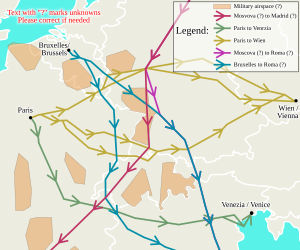
Improving air traffic management can help planes fly more direct routes instead of zigzagging. It can also help them fly at the best altitudes. This could reduce airline emissions by up to 18%. For example, a "Single European Sky" has been proposed since 1999 to make air travel more efficient in Europe and reduce CO2 emissions.
Operations Improvements
Besides CO2, planes also produce nitrogen oxides (NOx), particles, and contrails.
- Non-CO2 emissions: Flight routes can be planned to reduce the climate impact of these other emissions. For example, flying at slightly lower altitudes can reduce the warming effect of NOx and contrails, even if it means using a little more fuel.
- Nitrogen oxides (NOx): Plane designers are working to reduce NOx emissions from jet engines, and they have already fallen significantly.
- Particulates: Modern engines are designed to produce no smoke, unlike early jet engines.
- Unburned hydrocarbons (UHC): These are produced when fuel doesn't burn completely. Modern jet engines have mostly eliminated these through better design.
- Contrails: Contrail formation could be reduced by flying at lower altitudes, especially during night flights or in winter, which cause most of the warming effect from contrails. Avoiding areas with high humidity can also reduce contrails.
See also
 In Spanish: Impacto ambiental de la aviación para niños
In Spanish: Impacto ambiental de la aviación para niños
- Aviation Environment Federation, a UK organization concerned about aviation's impact.
- Energy efficiency in transport
- European Green Deal, a plan for making Europe climate-neutral.
- Environmental effects of transport
- Individual action on climate change, what individuals can do.


